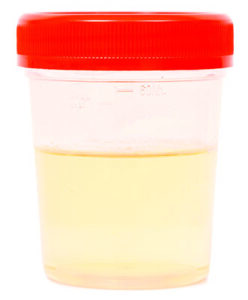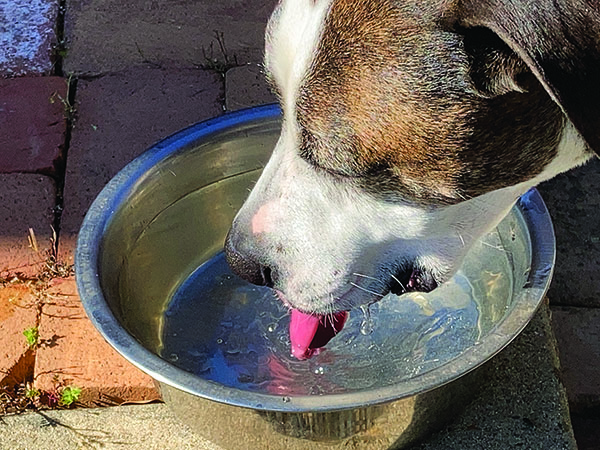Excessive thirst and urination (polyuria/polydipsia or PU/PD in veterinary terms) is a common complaint in dogs. Sometimes the owner doesn’t perceive it as a problem until the dog starts urinating in the house – then it’s a big problem! There are many – at least 25 – possible causes for poluria and polydipsia in dogs. This means your veterinarian needs to systematically rule things out one by one, until finally arriving at a diagnosis. It can be a process, so you’ll need to be patient and work with your veterinarian to get to the answers you need.
CONFIRMING PU/PD IN YOUR DOG
First, your veterinarian will need to confirm that your dog really has PU/PD. How much water dogs need in a day varies a lot, depending on activity level, the moisture level of the dog’s food, exercise, environmental temperature and humidity. However, a good general guideline for normal water consumption is about an ounce of water per pound of body weight per day. So, 10 ounces for a 10-pound dog, 60 ounces for a 60-pound dog, etc.
Polydipsia in dogs is officially defined as drinking more than 100 mls of water per kg of the dog’s body weight per day. Veterinarians use milliliters and kilograms (kg) rather than ounces and pounds, but when you convert these values to those more familiar to dog owners, it works out to about 15 ounces for a 10-pound dog and 91 ounces for a 60-pound dog, etc.
Water intake is easy to measure if you have just one dog and you close the toilet lids, but not so easy with multiple pets in the house.
Another way to confirm true PU/PD is to collect a specimen of the very first urine your dog produces in the morning, before he starts drinking for the day, and bring it to your vet in order to run a test (called a urine specific gravity, USG) on this sample.
USG is a measure of the concentration of the urine. If your dog truly has PU/PD, the urine will be dilute. Your veterinarian may want you to drop off samples for this test for three or four days in a row for confirmation.
Next, your vet needs to make sure the PU/PD you’re observing isn’t simply a side effect of a medication your dog may be on. Phenobarbital, oral steroids like prednisone, diuretics like furosemide (Lasix), potassium bromide, and thyroid medication are all drugs that can cause excessive thirst and urination as a side effect. Topical steroids can do it, too, so eye drops, ear drops, and skin creams with cortisone may be the culprit. If you’re using cortisone cream on your own skin, don’t let your dog lick you!
FIRST TESTS FOR PU/PD IN DOGS

When you bring your dog in for his exam and PU/PD workup, be sure to bring a fresh “free catch” urine specimen with you. The workup starts with a physical examination, urinalysis, and blood work (chemistry screen and complete blood count or CBC). This combination can eliminate or confirm several of the causes of PU/PD in dogs right out of the gate, including two of the top three causes of PU/PD in dogs:
1. Chronic kidney disease
2. Diabetes mellitus
3. Cushing’s syndrome
Chronic kidney disease can usually be diagnosed based on the blood and urine samples, although the underlying cause may require further testing, such as urine culture and abdominal ultrasound.
Ruling out diabetes mellitus (DM) is easy: If there’s no sugar in the urine and the blood sugar is normal, there’s no DM.
At this point, your veterinarian will have plenty of hints regarding the likelihood of Cushing’s syndrome (more technically known as hyperadrenocorticism or HAC; i.e., overactive adrenal glands), including physical exam findings like classic skin and coat changes and a pot-bellied appearance, certain blood and urine abnormalities suggestive of HAC, and history of excessive hunger and panting at home. Definitive diagnosis requires further testing.
If needed, a low-dose dexamethasone suppression (LDDS) test should be done next to rule out HAC. This test requires a day-long stay in the hospital, with blood samples drawn at 0, 4, and 8 hours after a cortisone injection. If the baseline cortisol at 0 hours is not abnormally low, this effectively rules out the opposite adrenal gland disorder that can also cause PU/PD called Addison’s disease, which is underactive adrenal glands.
Other causes of PU/PD in dogs that can be easily determined with initial veterinary diagnostics include high blood calcium (hypercalcemia), which can occur with lymphoma and anal gland tumors (these are usually apparent on physical exam), uterine infection (pyometra) in unspayed females (this sometimes requires x-ray or ultrasound for confirmation), and liver disease.
FINAL ROUND OF TESTS FOR DIAGNOSING PU/PD IN DOGS
Let’s say you’ve done all this and everything up to this point is normal. The next possible causes of PU/PD in dogs that your veterinarian needs to rule out with specific blood tests are thyroid disease and leptospirosis. The latter is an infectious disease that often makes dogs very sick with kidney and liver disease, but sometimes causes only PU/PD in an otherwise apparently healthy dog.
If you’ve gotten this far without reaching a diagnosis, it’s time to rule out the final and least likely causes of PU/PD in dogs: central diabetes insipidus (CDI) and psychogenic polydipsia.
CDI happens when the dog’s body lacks a natural antidiuretic hormone (ADH), which is produced in the brain and released by the pituitary gland. ADH is necessary in order for the kidneys to concentrate urine. Without it, large volumes of dilute urine are excreted, regardless of hydration status or other physiologic demands for water. The dog then drinks copious amounts of water in a futile effort to replace what’s being lost in the urine. The result is PU/PD. CDI is often idiopathic (meaning we don’t know what causes it) but can occur with trauma, inflammation, or cancer in the brain.
Diagnosing CDI requires a trial with DDAVP (Desmopressin), which is a synthetic analog of ADH. It can be administered orally, by injection under the skin, or as a nasal or ocular drop, but it must always be administered under the direct supervision of a veterinarian, due to the possibility of severe complications. These include dehydration and dangerous electrolyte derangements, particularly during the trial. If the dog’s urine concentration increases and water consumption decreases during the trial, CDI is the diagnosis, and DDAVP is the treatment for life.
If the dog does not respond to DDAVP, psychogenic polydipsia is the presumptive diagnosis. This is a behavioral issue, where the dog starts drinking excessive amounts of water for no apparent reason. It can be quite extreme – all that water passing through can actually wash out the kidney’s ability to concentrate urine (this is called medullary washout). Once this happens, it’s a vicious cycle and requires time and gradual water deprivation (again, only under the direct supervision of a veterinarian) to reestablish normal urine concentrating ability.
IT’S A PROCESS
If your dog suffers from excessive thirst and urination, and you’re lucky, you’ll get answers with the first few steps and there will be a treatment for your dog’s underlying disorder. Remember that with each step in the process you’re ruling out diseases, which is a good thing!
With patience, you and your veterinarian can whittle away at all the things on the list until you reach a diagnosis and specific treatment. Then you can finally take a break from refilling the water bowl and letting the dog in and out. It will be a happy day!






I have just read the article about PU/PD, by Eileen Fatcheric, DVM. I was overwhelmed by the utter out of touchness. The first thing one needs to know is “how the h*** do I get a urine sample from my dog?” My fifteen pound furry mutt will NOT pee if he is confined–he once went 36 hours in the vet’s office where they were trying to get a urine sample. You could make a funny video of me, or some nice vet tech, following the little guy around trying to catch spontaneous urine with a cup/soup ladle/sponge.
I use a ladle to free catch a urine sample from my male dog. If you have him on a leash it’s pretty easy to place the ladle in a position to catch the stream when he lifts his leg.
I always have urine taken directly from the bladder with a fine needle. This is done all the time. “Cystocentesis is a common clinical technique used to obtain a sample of urine directly from the urinary bladder of dogs and cats when collecting a voided, or free-catch, aliquot is not preferred. The procedure is indicated when necessary to obtain bladder urine for culture purposes.”
Our 13 yr old boy spent the day at the vet this past week for multiple tests related to just this issue. Drinking like crazy and peed the bed 3x last week, very unusual for him. They did draw his urine directly from the bladder to get a pristine sample. None of the tests, including a chest/abdomen X-ray, showed anything out of the ordinary. Hoping to get blood test results today.
I found the info about the psychogenic polydipsia intriguing because he does have some OCD behaviors and we were actually wondering if it was another manifestation of some of those behaviors, which we call “sucking his thumb.”
WDJ, you rock once again. I actually laughed when this popped up in my email. Timely!
We recently went through this with my dog. Months of trying to figure out why she was so thirsty. LDDST was normal. We went to an internal medicine specialist who wanted an ultrasound before formally calling it psychogenic polydipsia. Unfortunately they found a pretty sizable adrenal tumor instead. Opted to provide palliative care instead of surgery.
Interestingly we did a trial of injectable desmopressin just to see if it helped, and it did; PU/PD magically gone. So 6 months later, she’s still getting injections twice a day and is doing amazingly.
She’s almost 13, and a pit/ACD mix.
How much water should I allow my dog to drink?
When my dog suddenly acquired this behavior, we were out of state on a vacation. I feared the worst, but my ongoing mistrust of purchased (high end) kibble kicked in and, after about a week of symptoms, I changed her food. Instant return to normal. I assume the kibble had been tainted with some misapplication of ingredients. She never got kibble of any kind again, and never experienced another day of inappropriate water intake. Bottom line, always take a close look at the dog’s diet to evaluate the onset of any symptoms with a change of diet, including just a new bag of the same food as usual.